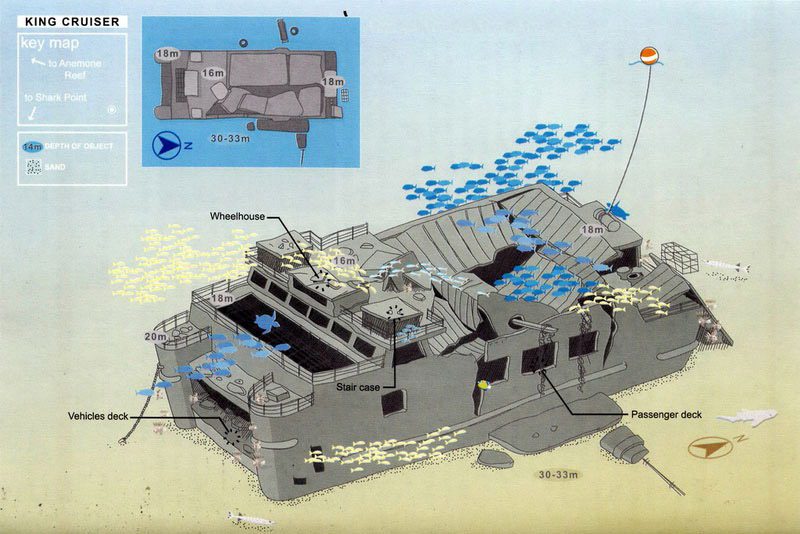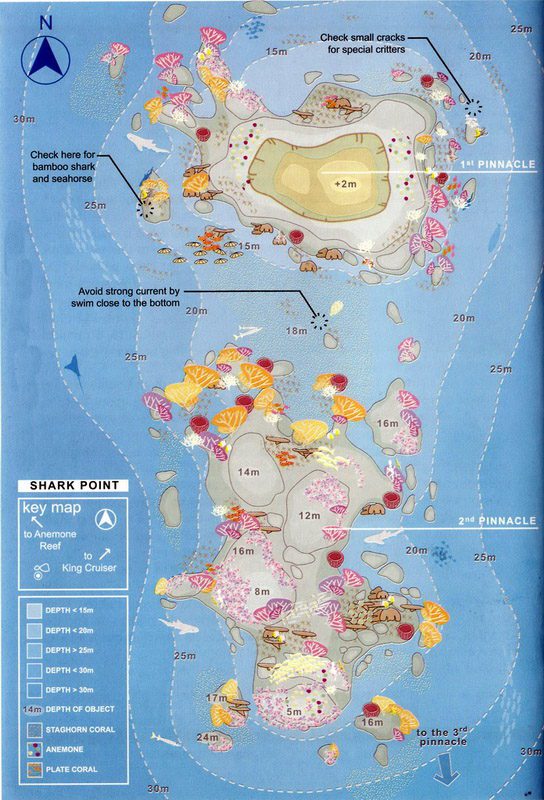The King Cruiser dive site
The King Cruiser Wreck is 85 meters (280 feet) long by 25 meters (82 feet) wide, with four decks and large passages that divers can use to gain easy access to explore the spacious interior. However, some parts of the King Cruiser wreck have noticeably deteriorated, and in mid-2003 the top deck at the stern collapsed into the middle section, so the wreck is now considered unsafe for penetration.
Divers can explore the passenger deck level at a depth of 18–22 meters (59–72 feet), while others may be more interested in checking out the remains of the wheelhouse at the top level. There is usually at least one buoy tied to the north side of the wreck.

The King Cruiser wreaked havoc on marine life.
For those interested in shark sightings, sometimes a leopard shark has been seen near the remains of the propellers at the sandy bottom. Gray and black bamboo sharks have been spotted at the opening around the middle level at the stern. During the high season, scuba divers may spot the largest fish on earth – the whale shark.
The incredible variety of marine life of the King Cruiser wreck makes it one of the most famous dive spots in Thailand—dozens of scorpionfish are usually camouflaged almost everywhere on the rusting steel of the wreck. Thus, divers are advised to be careful if they absolutely have to hold onto the part of the wreck. Along the stern, hovering lionfish are common, and divers may find themselves surrounded by schools of trevally, snapper, rabbitfish, fusilier or a mixture of several thousand fish at the top of the wreck.
Other creatures that can be spotted on the wreck are nudibranchs, eels, crabs, and a huge great barracuda.
King Cruiser wreck diving recommendations
The King Cruiser wreck can be intimidating for beginners or intermediate scuba divers because of the depth, the visibility, and the strong currents. For this reason, the recommended level to dive here is Advanced Open Water Diver with a minimum of 20 dives, or equivalent certification. We also recommend diving with Nitrox.
To avoid injury, it is advisable to study the structure and participate in the briefing provided by the divemasters before the dive. If the current is strong, there is usually one side of the wreck that is protected and practicable. Although penetration of the wreck is highly hazardous, there are still large openings that divers can swim through; for your safety, follow the instructions provided by your divemaster. Also make a habit to constantly check your air and dive computer throughout the dive since
the average depth of this dive site is quite deep and diving conditions are strenuous.
Shark Point dive site
Shark Point was named for the frequent sightings of leopard sharks in the area. Known as Hin Mu Sang by locals, this dive site lies near the Anemone Reef and King Cruiser wreck, and is made up of 3 main pinnacles and is located 27km from Phuket.
This site has the greatest diversity of fish and coral among all the Phuket and Phi Phi Islands dive sites. Each pinnacle is 15-20 metres apart and is covered in purple and pink soft corals, as well as beds of table coral, staghorn coral, coral head, and massive sea fans.The average depth is 15m and the maximum is 30m.
The dive usually starts at one pinnacle and finishes at the next, depending on the currents. As there is a great diversity of marine life, it is almost impossible to cover all the 3 pinnacles in one dive.
Marine life at Shark Point
As the site name suggests, Shark Point is the place to go for divers eager to spot leopard sharks. However, sharks are not the only highlight of the site. The seahorse and ornate ghost pipefish provide divers with a pleasant surprise among the sea fans and coral.
Some species of marine life that inhabit the area are scorpionfish, lionfish, pufferfish, and blue-ringed angelfish. On the rock and between corals, look for colourful nudibranchs, dancing shrimps, and boxfish. Above the reef, there are also schools of barracuda and yellow line snappers.


Koh Dok Mai diving: dive site facts
This little limestone island stretches vertically down to 30 meters (100 feet), creating a wall all around. Although the west side, with hard coral extending out from 12 meters (40 feet) to 20 meters (66 feet), is shallower, the east wall is more popular with scuba divers. There are many cracks and crevices along the walls of Koh Dok Mai Phuket at all depths, but the most frequented are the big cave and small cave located on the east side of Koh Dok Mai. However, the small cave is narrow and long, so divers who have not obtained a cavern specialty or any equivalent certification are not encouraged to penetrate the cave. There is no access to the island.
A good variety of small creatures makes this site a favorite for scuba diving activities. Tiger-tale seahorse, ornate ghost pipefish, and anglerfish are among the species frequently found along the wall Dive slowly and check crevices in the wall or the sea fans, and you may spot them when they move.
The walls are also a paradise for macro photographers, as colorful nudibranchs, flatworms, tiny white-eyed morays, and groups of 10 or more dancing shrimp are guaranteed to make an appearance. Do examine cracks and small crevices for giant morays and enjoy the schools of yellowline snapper, trevally, and fusiliers that usually swim along the wall.
For those interested in bigger fish, look at the blue for great barracuda and leopard shark, which may also catch a few winks at the bottom of the wall.
